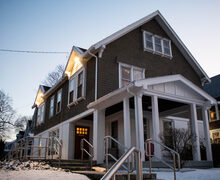DCC coordinator discusses Native American disability history
Francis Tang | Asst. Copy Editor
Kate Corbett Pollack, a coordinator at Syracuse University’s Disability Cultural Center, said Indigenous people were forced into psychiatric hospitals and schools.
Kate Corbett Pollack, a coordinator at Syracuse University’s Disability Cultural Center, talked about Native American disability history at a lecture on Wednesday at the Schine Student Center.
Pollack spoke about the history of segregated behavioral health and psychiatric facilities designed for Indigenous people with disabilities. During her lecture, Pollack listed multiple psychiatric facilities across the U.S., including in South Dakota, New York and Alaska. One of these facilities, the Utica Psychiatric Center, formerly known as the New York State Lunatic Asylum, was one of the first in the country and is now an archives facility.
Pollack said Indigenous people were forcibly admitted to these facilities, regardless of whether they had mental illnesses. Many of the psychiatric hospitals existed as an institution to assimilate Indigenous people into white-dominant society. Many Indigenous people in the psychiatric hospitals did not have mental illnesses but were rebelling against assimilation or not able to act in accordance to “white supremacist rules.”
Morningside Hospital in Portland, Oregon, for example, came under scrutiny in 1916 for never releasing any of its patients, and again in the 1940s for labeling patients without substantial diagnosis.
The Onondaga County Poorhouse is also associated with this part of history, Pollack said. Many different types of people — including those with disabilities, alcoholism or illness, as well as older people and people experiencing poverty — would be sent to the facility and buried in unmarked graves after they died. The property is now occupied primarily by Onondaga Community College.
Indigenous children were separated from their families when they arrived at the Onondaga County Poorhouse and were sent to schools such as Thomas Indian School, established in 1855 near the Cattaraugus Reservation in Erie County, New York.
Those children were punished for speaking Indigenous languages as part of the effort to assimilate the Indigenous population, Pollack said. Many children died at those schools and were buried in unmarked graves, the same way as they were at the Onondaga County Poorhouse.
Disability is just a type of diversity. Humans are biodiverse.Kate Corbett Pollack, SU Disability Cultural Center coordinator
In May, the remains of 215 Indigenous children were found at a similar former assimilation school and psychiatric hospital in Canada, sparking public outcry. The numbers are expected to rise, with speculation of 4,000 to 10,000 Indigenous students possibly buried in unmarked graves on the properties of these schools and at former schools in the United States.
Pollack said even in modern times, Indigenous children are 11 times more likely to be placed in foster care than white children in South Dakota. In South Dakota, the local government often takes Indigenous children from parents with disabilities and puts them into foster care, according to Pollack’s presentation.
“They’re using marginalized people for money. Children were sent to non-Native homes. That happened quite a bit for Native children — much more than white children,” Pollack said. “So, this is an example of how this continues to this day.”
Regina Jones, assistant director of SU’s Native Student Program and a member of the Oneida Nation, said she was “shocked” when she heard about the Thomas Indian School’s history that she didn’t know before.
“Disability is just a type of diversity. Humans are biodiverse,” Pollack said. “There’s not one type of human, not the best type of human.”
Published on November 18, 2021 at 1:53 am
Contact Francis: btang05@syr.edu | @francis_towne





